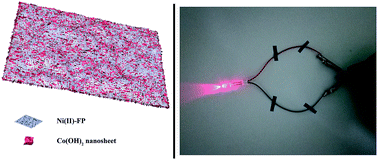Laboratory filter paper as a substrate material for flexible supercapacitors†
Abstract
In this study, a flexible asymmetrical solid-state filter paper-based supercapacitor was fabricated. Common laboratory filter paper (FP) provides toughness and flexibility to the whole device. Simply, traditional electroless Ni plating and electro-deposition were introduced to change the electrical conductivity of FP as a flexible and conductive substrate material. Then, the electrochemical active material Co(OH)2 and active carbon (AC) were respectively coated on the conductive Ni paper through electro-deposition and physical coating methods to prepare Ni/Co(OH)2-FP as a positive electrode and Ni/AC-FP as a negative electrode. Moreover, they were separated by a piece of FP coated with an ionic gel electrolyte to assemble the flexible asymmetrical solid-state supercapacitors. This supercapacitor exhibits superior flexibility, large volume energy density (0.64 mW h cm−3), and good bending cycle performance (95.89% capacitance retention after 500 bending cycles). It has been demonstrated that the assembled supercapacitor can still power a red light-emitting diode (LED) indicator normally regardless of the bending state and bending frequency. This study may provide promising insights for the design and fabrication of a flexible asymmetrical solid-state supercapacitor in a flexible power supply for wearable and portable applications.

- This article is part of the themed collection: 2017 Sustainable Energy and Fuels HOT Articles


 Please wait while we load your content...
Please wait while we load your content...